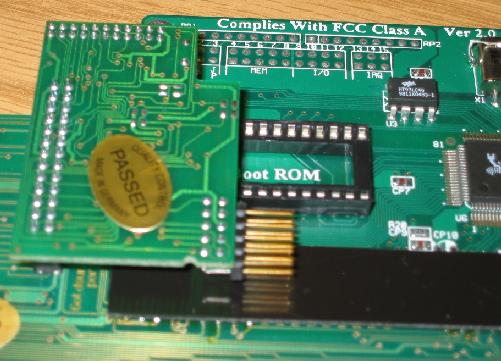Fully compliant RJ-45 connector
Realtek chipset, for all Amigas with Zorro-Slots, compatible with A1200
Zorro boards: Z4, Mikronik, RBM
multiple expansion possibilities: two clockports for A1200 expansions such
as Silversurfer and Hypercom, 26-pin expansion port just like Buddha/Catweasel
Z-II controllers
3,5" IDE port for harddisks and CD-Roms can be activated by the IDE-fix
Software package
Auto-negotiation acc. to IEEE 802.3, 10Base2 and 10Base-T supported
automatic Choice of the used connector
20MBit transfer rate (fullduplex, twisted-pair only)
16KByte buffermem for maximum performance
Autoprefetch for another increase of performance
automatic polarity correction for 10Base-T
Noise Filter Bus Interface ensures proper function in heavy-loaded Zorro-systems
compatible with Miami, Genesis, AmiTCP and all TCP/IP Stacks that can access
a Sana-2 driver
Sana-2 driver included, NetBSD driver available in the latest distribution
Nordic Global has announced an MNI driver for X-Surf 3 in Miami
all programming docs open (for Linux-drivers)

You can even add silversurfer or Delfina!
About X-surf:
X-Surf ("Cross-surf") is the world's most successful networking card
you can find for Zorro-Amiga computers. Initially it was shipped with a
minimum of software drivers, and we've added tools, drivers and installation
utilities over the years. Until today the X-Surf is easiest to install
among all Amiga networking cards. Looking at DSL-support, it's unique:
It comes with it's own PPPoE driver that is necessary for most DSL providers,
so high-speed internet access is possible with any TCP/IP stack. Operation
is possible starting with OS2.0. Since a TCP/IP stack is not included with
the board, we recommend using OS3.9, because that comes with the TCP/IP
stack Genesis.
Once you installed the TCP/IP stack, you can use all programs that need
a network on your Amiga: An IRC-client, a web browser or a network filesystem
that lets you access files of a computer that's in the same network. The
Samba-package (available freely on the Aminet) for example lets you exchange
files between Amigas and even between a Windows-PC and an Amiga!
Since installing Samba is a hard job (even pros sometimes fail to accomplish
this), an automatic installation CD is included with the X-Surf 2. The
installation script does all the necessary modifications in the forest
of Samba's configuration files for you. With this tool, it's even possible
for a rookie to install a network that really deserves the name "network":
You can even access a printer that is connected to the Windows-computer!
(only Win 95, Win98 and Win ME)
The large variety of expansion possibilities is an unparalleled added
value for most Amiga users. Most users are short of Zorro-slots, so the
possibility to connect a serial interface like the Silversurfer or the
VarIO can solve most space-problems in your Amiga. Since there's two clock-ports
on the X-Surf, you can connect two Silversurfer boards at a time. Both
can be accessed with the same silversurfer.device, just use the next unit
number. The clock-ports are two fully-featured ports that are hardware-compatible
with the pin header in A1200 computers. The driver software for A1200 expansions
only has to be modified in some details in order to make the add-ons work
with the X-Surf. There are no conflicts between the ports already present
in the system (A1200, the four clock-ports of the Z4 board or the Buddha
Flash port) and the new clock-ports of the X-Surf - they all can be used
at the same time.
The two IDE-ports should be considered as a free add-on. The necessary
drivers are included on the driver CD. The ports should not be considered
as full IDE ports, because you can't boot from them, and the timing is
not configurable. If you want these functions, we recommend a Buddha Flash
controller. The IDE ports are to be considered as temporary solutions if
you want to connect a 2,5" harddrive to an A2000, A3000 or A4000 without
buying further equipment such as a 3,5inch -> 2,5inch adapter. Owners of
an A3000 for example can boot off a SCSI harddisk, and activate a cheap
IDE harddrive and an Atapi CD-Rom. You shouldn't use a CD-writer on these
ports, because only one IO-request at a time can be started by the X-Surf
controller. That means a preemptive use of IDE devices - necessary for
CD-writers - is impossible on the X-Surf. For this purpose we recommend
a Buddha Flash controller.
Finally there is to emphasize that all expansion ports can be used at
the same time. For going to extremes, you can use a VarIO, a Silversurfer
on one, a Catweasel on the other clock-port, and four IDE/Atapi devices
at the same time while the network functions are not affected. All this
occupies only one of your precious zorro-slots! |